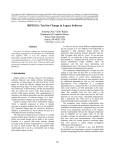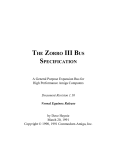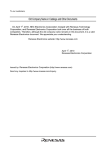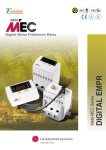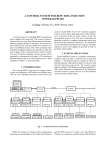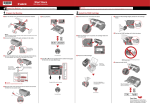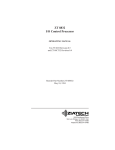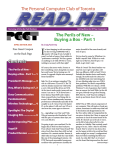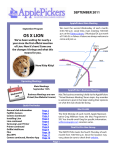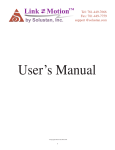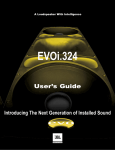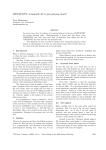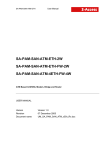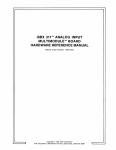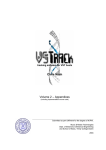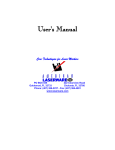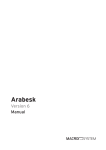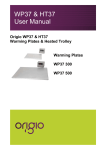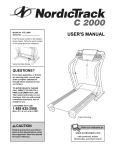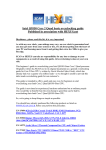Download Twin-X General Purpose I/O Board User`s Manual
Transcript
Twin-X General Purpose I/O Board User’s Manual ASDG Incorporated March 14, 1989 CONTENTS 2 Contents I NOTICES 5 1 Copyrights 5 2 Restrictions 5 3 Attributions 5 4 FCC Compliance 5 5 Disclaimer 6 6 Introduction 6 II 7 SPECIFICATIONS Electrical Specifications 7.1 7 7 Power Requirements . . . . . . . . . . . . . . . . . . . . . . . . . . . . . . . . . . . . . . . . . . 7 8 Environmental Specifications 7 9 Physical Specifications 8 10 Interface Features 8 10.1 Zorro Interface . . . . . . . . . . . . . . . . . . . . . . . . . . . . . . . . . . . . . . . . . . . . . . 8 10.2 iSBX Interface . . . . . . . . . . . . . . . . . . . . . . . . . . . . . . . . . . . . . . . . . . . . . . 8 11 Interface Pinouts 10 11.1 Zorro Interface . . . . . . . . . . . . . . . . . . . . . . . . . . . . . . . . . . . . . . . . . . . . . . 10 11.2 IEEE 959 (iSBX) Interface Connections. . . . . . . . . . . . . . . . . . . . . . . . . . . . . . 11 CONTENTS 3 III USER INFORMATION 11 12 Module Installation 11 13 Installing Cables And Brackets 12 14 Setting DIP Switches 12 15 Jumper Settings 12 15.1 J1: ASDG / Non-ASDG Modules . . . . . . . . . . . . . . . . . . . . . . . . . . . . . . . . . . 14 15.2 J2: Single / Dual Modules . . . . . . . . . . . . . . . . . . . . . . . . . . . . . . . . . . . . . . . 14 15.3 J3-J6: Extended Module Addressing . . . . . . . . . . . . . . . . . . . . . . . . . . . . . . . . 15 15.4 J7: Interrupts . . . . . . . . . . . . . . . . . . . . . . . . . . . . . . . . . . . . . . . . . . . . . . . 15 16 LED Functional Descriptions 16 17 Installing Twin-X In An Amiga 2000 17 IV PROGRAMMERS INFORMATION 17 18 Config Space 18 19 iSBX / IEEE 959 Interface Overview 19 20 Byte (8-Bit) Mode Module Addressing 19 21 Word (16-Bit) Mode Module Addressing 20 22 Twin-X Module Status 21 23 Using Extended Module Addressing Jumpers (J3 to 36) 21 24 Using Module DMA Features 23 CONTENTS V SERVICE AND REPAIR INFORMATION 4 23 5 Part I NOTICES 1 Copyrights This User’s Manual is copyrighted 1988 by ASDG Incorporated. All rights are reserved worldwide. 2 Restrictions The contents may not, in whole or in part, be copied, photocopied, reproduced, or reduced to any electronic medium or machine readable form, stored in any retreival system, or translated into any human or machine language without prior consent in writing from ASDG Incorporated. 3 Attributions Amiga is a trademark of Commodore-Amiga, Inc. Twin-X is a trademark of ASDG Incorporated. iSBX and Multibus are trademarks of Intel Corporation. 4 FCC Compliance WARNING: This equipment generates, uses, and can radiate radio frequency energy and if not installed and used in accordance with the instructions manual, may cause interference to radio communications. It has been tested and found to comply with the limits for a Class A computing device pursuant to Subpart J of Part 15 of FCC Rules, which are designed to provide reasonable protection against such interference when operated in a commercial environment. Operation of this equipment in a residential area is likely to cause interference in which case the user at his own expense will be required to take whatever measures may be required to correct the interference. If you suspect interference, you can test the product by turning the Amiga off and on with this product installed and not installed. If this product does cause interference, try the following: 1. Reorient the antenna or AC plug on the affected equipment. 2. Change the relative positions of the Amiga and the affected equipment. 3. Move the Amiga farther away from the affected equipment. 5 DISCLAIMER 6 4. Plug either the Amiga or the affected equipment into a different outlet so that the Amiga and the affected equipment are on different circuits. Use only shield-grounded cables when connecting peripherals to the Amiga. All peripherals must be labeled to comply with the FCC emissions requirements. Class B certified devices will usually have lower emissions than Class A devices. Operation with unlabeled peripherals is likely to result in interference. Use this equipment only with three-pronged type (AC ground) AC wall recepticals. If necessary, consult your dealer or an experienced Radio Frequency Interference technician for additional suggestions. You may find the FCC booklet “How to Identify and Resolve Radio-TV Interference Problems” helpful. It is available from the U.S. Government Printing Office, Washington, D.C. 20402, stock no. 004-000-00345-4. 5 Disclaimer THIS MANUAL HAS BEEN CHECKED AND IS BELIEVED TO BE ACCURATE AND CORRECT AND IS SUBJECT TO CHAxNGE WITHOUT NOTICE. THE INFORMATION IN THIS MANUAL IS PROVIDED “AS IS” WITHOUT WARRANTY OF ANY KIND, EITHER EXPRESS OR IMPLIED. THE ENTIRE RISK AS TO THE ACCURACY OF THE INFORMATION HEREIN IS ASSUMED BY THE USER. ASDG INCORPORATED DOES NOT WARRANT, GUARANTEE, OR MAKE ANY REPRESENTATIONS REGARDING THE USE OF, OR THE RESULTS OF THE USE OF, THE INFORMATION IN TERMS OF CORRECTNESS, ACCURACY, RELIABILITY, OR OTHERWISE. ASDG INCORPORATED WILL NOT BE LIABLE FOR DIRECT, INDIRECT, INCIDENTAL OR CONSEQUENTIAL DAMAGES RESULTING FROM ANY DEFECT IN THE INFORMATION EVEN IF ASDG INCORPORATED HAS BEEN ADVISED OF THE POSSIBILITY OF SUCH DAMAGES. SOME STATES DO NOT ALLOW THE EXCLUSION OR LIMITATION OF IMPLIED WARRANTIES OR LIABILITY FOR INCIDENTAL OR CONSEQUENTIAL DAMAGES, SO THE ABOVE LIMITATION OR EXCLUSION MAY NOT APPLY TO YOU. 6 Introduction Congratulations on the purchase of your new Twin-X expansion board. This board will allow you to add one or two IEEE 959 (iSBX) expansion modules to your Commodore Amiga computer. This provides the Amiga with the ability to communicate through the wide variety of interfaces that IEEE 959 modules exist for. The iSBX standard was originally defined by Intel Corporation as part of their Multibus board 7 interface standard. The module concept was used to allow the customer to define his own system by combining a general purpose base board with the modular I/O function necessary for his application. The standard was later submitted to, and accepted by, the Institute of Electrical and Electronic Engineers (IEEE) as an industry wide standard (IEEE 959). There are a wide variety of Twin-X compatible modules available from many manufacturers. Examples include RS 232 ports, counter/timers, relay outputs, parallel I/O, stepper motor controllers, IEEE 488 controllers, SCSI host adapters, analog to digital converters, battery backed up RAM, Modems, prototyping modules, speech synthesizers, barcode readers, floating point coprocessors, floppy disk controllers, digital to analog converters, graphics controllers, and Centronics printer interfaces. Call ASDG for a partial listing of available modules and current manufacturers. Let us help you find the module to fit your needs. ASDG can also design modules and write software drivers to help you with your custom projects. Part II SPECIFICATIONS 7 Electrical Specifications 7.1 Power Requirements Twin-X Base Board +4.75 to 5.25Vdc at 1.8 A Max. (1.4 A Typical) SBX Modules (each) +4.75 to +5.25Vdc at 3.0 A Max. + 11.4 to +12.6Vdc at 1.0 A Max. -12.6 to -11.4Vdc at 1.0 A Max. 8 Environmental Specifications The Twin-X board is rated for the following environmental conditions: • Storage Temperature........-40 to +70 degrees C • Operating Temperature.......0 to +55 degrees C • Relative Humidity...........5 to 85% (non-condensing) 9 9 PHYSICAL SPECIFICATIONS 8 Physical Specifications Due to adherence to the IEEE 959 physical specification and to module cooling requirements, TwinX fitted with many IEEE 959 modules will consume two Amiga 2000 Zorro slots. Should the Twin-X be installed in the first Amiga 2000 Zorro slot, however, only one slot will be consumed. Even if a Twin-X (with modules attached) should appear to fit within a single Amiga 2000 Zorro slot, ASDG does NOT reccomend that the system be operated in this way. This is because most modules require direct airflow to operate correctly. Maximum 5.50" high by 13.85" long by 1.17" deep (including rear panel bracket and iSBX modules) See Figure 1 for a drawing of the Twin-X physical specifications. 10 Interface Features 10.1 Zorro Interface • Separate auto config space for each iSBX module • Second config space may be turned off if only one iSBX module is to be used • DIP switches and jumpers define module types to allow full auto-configuring • Each module occupies one standard Amiga I/O space • All address, data and control lines are buffered to prevent bus loading • No wait states with most iSBX modules. Wait states automatically added for iSBX modules that require slower accesses • Jumper block provided to connect iSBX module interrupts to Amiga interrupt lines allowing user defineable priorities 10.2 iSBX Interface • iSBX bus baseboard with D16/16 I compliance level • Supports 8 and 16 bit modules • Supports interlocked operations using MWAIT* signal • Supports two single wide or one double wide module Twin-X General Purpose I/O Board iSBX Module In Position 2 Figure 1: Twin-X Physical Specifications Length 13.85" iSBX Module In Position 1 Height 5.50" Max. Width 1.17" Max. 11 INTERFACE PINOUTS 10 • Allows the connection of iSBX DMA request lines to Amiga interrupt lines • Allows Amiga access to the iSBX DMA acknowledge port for software flexibility • Allows additional address lines to be connected to the module through the iSBX OPT0 and OPT1 lines • Provides a 10MHz MCLK and supports use of MPST* to determine if a module is installed 11 Interface Pinouts 11.1 Zorro Interface The Twin-X supported Zorro interface signal lines are shown in Figure 5 below. Pin No. --1 3 5 7 9 11 13 15 17 19 21 23 25 27 29 31 33 35 37 39 41 43 45 47 Signal Name -----Ground Ground +5VDC --/SLAVE /CFGOUT Ground ----/INT2 A5 A6 Ground A2 Al ------Ground ------A16 A17 Pin No. --2 4 6 8 10 12 14 16 18 20 22 24 26 28 30 32 34 36 38 40 42 44 46 48 Signal Name -----Ground Ground +5VDC --+12VDC /CFGIN ----XRDY -12VDC /INT6 A4 A3 --— ----------— /EINT7 /EINT5 /EINT4 /BEER --- Pin No. --51 53 55 57 59 61 63 65 67 69 71 73 75 77 79 81 83 85 87 89 91 93 95 97 Signal Name -----------A22 A23 Ground D15 D14 D13 D12 D11 Ground D0 D1 D2 D3 D4 Ground Ground Ground Ground DOE --— --— Pin No. --52 54 56 58 60 62 64 66 68 70 72 74 76 78 80 82 84 86 88 90 92 94 96 98 Signal Name -----A18 A19 A20 A21 --------READ /LDS /UDS /AS D10 D9 D8 D7 D6 D5 Ground Ground --/BUSRST /EINT1 --- 11 49 Ground 50 --- 99 Ground 100 Ground Figure 5: Twin-X Zorro Interface Signals 11.2 IEEE 959 (iSBX) Interface Connections The Twin-X supported iSBX interface signal lines are shown in Figure 6 below. Pin No. --1 3 5 7 9 11 13 15 17 19 21 Signal Name -----+12VDC GND RESET MA2 MA1 MA0 IOWRT* IORD* GND MD7 MD6 Pin No. --2 4 6 8 10 12 14 16 18 20 22 Signal Name ------12VDC +5VDC MCLK MPST* --MINTR1 MINTR0 MWAIT* +5VDC MCS1* MCS0* Pin No. --23 25 27 29 31 33 35 37 39 41 43 Signal Name -----MD5 MD4 MD3 MD2 MD1 MD0 GND MD14 MD12 MD10 MD8 Pin No. --24 26 28 30 32 34 36 38 40 42 44 Signal Name ---------(MA4) (MA3) MDACK* MDRQT +5VDC MD15 MD13 MD11 MD9 Figure 5: IEEE 959 (iSBX) Interface Signals Part III USER INFORMATION 12 Module Installation Each iSBX module that you receive should include a threaded nylon standoff and two nylon screws (double wide modules should contain three sets of these). Mount the standoff(s) to the module on the same side as the iSBX interface connector using the mounting holes provided in the module. Snap the module firmly in place over one of the two blue connectors on the Twin-X board. If only one module is used, it should always be placed in the Module 1 position on the Twin-X board (This applies to single and/or double width modules). The module may now be screwed in place using the remaining nylon screw(s) from the solder side of the Twin-X board. 13 INSTALLING CABLES AND BRACKETS 12 A double wide module will snap in place over the blue connector for Module 1. Two of its three standoffs will line up with mounting holes in the Twin-X board. Screw the module in place using nylon screws through these two holes. 13 Installing Cables And Brackets Modules provided by ASDG will include cables and brackets to allow all necessary connectors to be available at the rear of the Amiga. Modules provided by other vendors will usually not include cables or brackets for use in the Amiga computer. ASDG may be able to provide cabling and/or brackets to fit your needs if you can not make or procure them yourself. Install cables onto the iSBX modules being careful to match pin 1 of the cable connector to pin 1 of the module connector. Most cable connectors will have a raised or inset arrow indicating pin 1 or they may have pin numbers set in the plastic of the connector. Pin 1 of the module connector should be clearly marked in the silkscreen of the printed circuit board or pointed out in the manual for the module. Install the brackets at the other end of each of the cables into Amiga rear panel. 14 Setting DIP Switches There are two sets of DIP switches on the Twin-X board. The set labeled DS1 is used for Module 1 and the DS2 DIP switches are for Module 2. Driver software will read the DIP switches to determine what types of iSBX modules are present. ASDG supplies a jumper settings list for each of the modules that it supplies software support for. Set DS1 for the type of module located in Module Position 1 and DS2 for the module type located in Module Position 2. If you are not using ASDG supplied software, you may use any DIP switch setting to identify the module to your software. Leave the J1 jumpers corresponding to this module position out to prevent this user defined setting from being confused with the ASDG defined settings. 15 Jumper Settings ASDG supplies a jumper settings list for each of the modules that it supplies software support for. Please see Figure 2 for a diagram showing the locations and numbering of the Twin-X jumper blocks and DIP switches. DS1 & DS2 DIP Switches Numbering is on the switches and on the board silk screen next to the switches 2 4 6 8 • •• •• •• 1 3 5 7 J1 Pin Numbers J3 2 1 •• • • 2 J4 1 J3 and J4 Pin Numbers 3 1 2 1 •• 2 J6 1 J5 and J6 Pin Numbers J5 2 J2 Pin Numbers 1 2 3 4 5 6 7 8 9 10 11 12 13 14 15 16 17 18 19 20 21 22 ••••••••••••••••••••• J7 Pin Numbers Jumper Locations And Numbering Figure 2:Twin-X General Purpose I/O Board 15 JUMPER SETTINGS 14 15.1 J1: ASDG / Non-ASDG Modules The J1 settings are used along with the DIP switch settings to allow the software to identify the types of modules present. The numbering and position definitions of J1 are as follows: J 1 J 1 o o o o 1 3 5 7 = o o o o 2 4 6 8 Figure 1: J1 Jumper Positions Jumper Connection ---------1 to 2 3 to 4 5 to 6 7 to 8 Function When Installed ------------Reserved ASDG Software Reserved ASDG Software Function When Not-Installed ------------Standard Module Non-ASDG Software Standard Module Non-ASDG Software Defined For -------Module 1 Module 1 Module 2 Module 2 Table 1: J1 Jumper Definitions 15.2 J2: Single / Dual Modules The position of jumper J2 determines whether one or two config spaces, and therefore modules, will be seen by the Amiga. If two modules are present on the Twin-X board, the jumper should be in the upper position. If only one module is present, the jumper should be in the lower position and the module present must be in Module Position 1. o o o 1 = 2 3 Figure 2: J2 Jumper Positions 15 JUMPER SETTINGS 15 Jumper Connection ---------1 to 2 2 to 3 Function Defined ------------Dual Modules Single Module Table 2: J2 Jumper Definitions 15.3 J3-J6: Extended Module Addressing Jumpers J3 to J6 allow additional address lines to be connected to the iSBX interface for use with non-standard modules. Adding these address lines is not part of the standard iSBX or IEEE 959 specification. These jumpers should be left off for use with most standard iSBX modules. The ability to connect to these additional address lines was added to the Twin-X board to allow custom I/O modules to be designed that require more addressing space. See the PROGRAMMERS INFORMATION section for more information on how these lines may be used. o o J3 1 1 J4 o o = J3 o o J4 2 2 J5 1 1 J6 = o o J5 J6 2 2 Figure 3: J3 to J6 Jumper Positions Jumper Signal Module Installed Added Affected --------------------J3 MA3 Module 1 J4 MA4 Module 1 J5 MA3 Module 2 J6 MA4 Module 2 Note: Leave These Jumpers Out For Standard Modules Table 3: J3 to J6 Jumper Definitions 15.4 J7: Interrupts Jumper J7 allows the module interrupt and DMA request lines to be connected to any of the Amiga 2000 interrupt lines. Interrupts on standard Amiga expansion boards should connect to either /INT2 or /INT6 on 16 LED FUNCTIONAL DESCRIPTIONS 16 the Zorro bus. The Twin-X board allows any of the iSBX interrupts and/or DMA requests to be connected directly to Zorro /INT2 or /INT6 with a jumper shunt. Connections to the other Zorro bus interrupts is possible, but requires a jumper connection using wire wrap wire. All of the interrupt and DMA request outputs in this jumper block are driven by open collector drivers, allowing more than one to be connected to the same interrupt signal line. Connections other than those called out on the jumper settings sheet may cause incorrect Amiga operation. One common symptom of wrong or unnecessary connections in the J7 space is the Amiga not getting far enough in its initialization sequence to ask for the workbench disk. Be sure to check these jumper settings very carefully. J7 o 1 o o 3 o o o 5 o o 7 o 9 o o 11 o o 13 o o 15 o o 17 o o o 19 o o 21 Figure 4: J7 Jumper Positions J7 Pin: 1 Signal: /EINT7 2 /EINT5 3 /EINT4 4 /EINT1 J7 Pin: Signal: 5 /INT6 6 M1INT0 7 /INT2 8 /INT6 9 M1INT1 10 /INT2 J7 Pin: Signal: 11 /INT6 12 M1DRQT 13 /INT2 14 /INT6 15 M2INT0 16 /INT2 J7 Pin: Signal: 17 /INT6 18 M2INT1 19 /INT2 20 /INT6 21 M2DRQT 22 /INT2 Table 4: J7 Jumper Definitions 16 LED Functional Descriptions The LEDs provide feedback to the user on the Twin-X board activity. The LED information allows programmers and system designers to verify the auto-configuration of the boards in the system and see the relative access rate to each of the modules on the Twin-X board. The “MODULE-1 CONFIG” LED will go on AFTER the first module has been linked into the Amiga I/O space as part of the auto-configuration process. This occurs a few seconds after power up or reset. The LED should remain on until the next power down or reset. 17 INSTALLING TWIN-X IN AN AMIGA 2000 17 The “MODULE-2 CONFIG” LED will go on AFTER the second module has been linked into the Amiga I/O space. If the Twin-X board is jumpered for single module operation (J2 is in the lower or S position), this LED should not come on. Twin-X boards jumpered for single module operation have only one config space and the Amiga will not map the second module into the I/O space. The “MODULE-1 SELECT” LED will go on during each access to module 1 and the “MODULE2 SELECT” LED will go on during each access to module 2. The length of most accesses is less than 1 microsecond, so it takes quite a few module accesses per second before the LEDs will appear to be glowing. The relative brightness of the SELECT LEDs indicates the percentage of the time the modules are being accessed. An LED that appears to be off indicates no or very low module activity and a brightly lit LED shows that the module is being accessed most of the time. 17 Installing Twin-X In An Amiga 2000 A small to medium size Phillips screw driver is required to install a Twin-X board in an Amiga 2000. Remove the screws along the bottom of the sides of the Amiga 2000. There are two screws along the lower edge of each side of the machine. Remove the screw in the top center of the back of the Amiga 2000. This screw is located between a similar looking screw which holds in the top corner of the power supply and a smaller screw which holds the bracket for the coprocessor slot in place. Grasp the cover on both sides and slide it toward the front of the Amiga 2000 and up. Unscrew the bracket for the slot the Twin-X board will be mounted in and remove it from the system. Install the Twin-X board in the slot you have decided on, making sure that the board seats firmly in the connector. Re-use the screw you removed above to screw the Twin-X board bracket in place. Remove other brackets from the back of the Amiga as needed. Replace them with the new brackets that have your Twin-X I/O cables on them. Re-install the cover of the Amiga by reversing the steps you used to remove it. 18 Part IV PROGRAMMERS INFORMATION 18 Config Space The Twin-X board has a separate config space for each of the two module positions. The only difference between the two config spaces is that the config space for module 1 will have the Chained Config Request bit set in nibble 2 if J2 is set in the upper (dual module operation) position. This bit set indicates to the programmer that there are two config spaces on this board. If J2 is in the lower (single module operation) position, this bit will not be set and the second config space (along with the module in Module Position 2) will not be seen by the Amiga. The config space provides Amiga driver software with information on the board type, the amount of memory space it occupies, the manufacturer and a serial number. The Twin-X board uses the serial number space to pass the DIP switch and J1 jumper information to the software. The software can use this information to determine what iSBX module type is represented by that data. Twin-X config data is as follows: Nibbles: -------00/02 Bits 7 to 0: -----------1100 X001 Notes: -----Current style board, don’t link in memory free list, size = 64 kilobytes and the X is for the Chained Request Bit which is explained above. 04/06 1111 1111 Product Number = 255 08/0A 0100 0000 Any space is OK, Cannot be shut up 0C/0E 0000 0000 Reserved 10/12 14/16 0000 0011 1111 1111 ASDG manufacturers id 18/1A 1C/1E 20/22 0000 0000 0000 0000 0000 00XY 24/26 XXXX XXXX Serial Number, Serial Number, Serial Number, X=l for J1:l-2 Y=l for J1:3-4 Serial Number, byte 0 (msb) byte 1 byte 2 connected, X=0 for 1-2 open connected, Y=0 for 3-4 open byte 3 (lsb) Contents of DIP 19 ISBX / IEEE 959 INTERFACE OVERVIEW 19 switches show up here. DIP switch 8 is in data bit 7 and DIP switch 1 is in data bit 0. An open switch is a 0 and a closed or “ON” switch is a 1. These serial number values are used to identify the type of module present. All Others 0000 0000 The rest of the config space is all 0’s 19 iSBX / IEEE 959 Interface Overview The basic iSBX (IEEE 959) interface is comprised of 8 or 16 data lines, 3 address lines, 2 chip select lines, a WAIT line, and read and write strobes. In byte mode, the two chip selects and three address lines provide a total of 16 possible register locations. The two chip selects are driven at the same time to indicate word (16 bit) mode accesses, so there are still only sixteen bytes accessible (addressed as eight words). The iSBX (IEEE 959) interface also provides two interrupt lines, a DMA request line (which is used as another interrupt source on Twin-X), a DMA acknowledge line (which Twin-X treats as another memory mapped chip select), a 10 MHz clock line, and a reset line (controlled by the Amiga reset signal). The Twin-X board provides the option to connect two more address lines to the iSBX interface through jumpers (J3 and J4 for Module Position 1 or J5 and J6 for Module Position 2). This increases the address space available for use on custom module designs, but is not a part of the iSBX or IEEE 959 standard. 20 Byte (8-Bit) Mode Module Addressing Most iSBX module manuals define their module registers in relation to the three address lines and the two chip selects. Below is a table of the address offsets from the base of the Twin-X module address space. The “Ox” numbers under the “Chip Select Lines” columns are hex offsets from the module base address. The address of a register on a IEEE 959 module is found by adding: Module Base Address + Hex Offset = Address Of Specific Register Each module’s base address gets written into Twin-X base address registers by the Amiga as the system is configured after powerup. The specific location that a module I/O space was mapped to is available to the programmer through the Amiga’s ConfigDev List. Each module on the Twin-X board has a separate config space and will receive a separate base address. 21 WORD (16-BIT) MODE MODULE ADDRESSING Address Lines MA2 MA1 MA0 ------0 0 0 0 0 1 0 1 0 0 1 1 1 0 0 1 0 1 1 1 0 1 1 1 Chip Select MCS0* ----0x01 0x03 0x05 0x07 0x09 0x0B 0x0D 0x0F 20 Lines MCS1* ----0x41 0x43 0x45 0x47 0x49 0x4B 0x4D 0x4F Table 5: iSBX Module Offsets For 8 Bit Accesses 21 Word (16-Bit) Mode Module Addressing In word data mode, both module chip select lines go low (true) on each access. Below is a table of the offsets from the module base for 16-bit accesses. Note: User’s should try to avoid making word accesses to modules that are designed for byte (8bit) accesses only. This is because many 8-bit modules use the two chip selects for different module features and do not protect against having two sets of chips driving the data lines at the same time (which can cause damage to the module). Address Lines MA2 MA1 MA0 ------0 0 0 0 0 1 0 1 0 0 1 1 1 0 0 1 0 1 1 1 0 1 1 1 Chip Select Lines MCS0* and MCS1* ----------------0x00 0x02 0x04 0x06 0x08 0x0A 0x0C 0x0E Table 6: iSBX Module Offsets For 16-Bit Accesses 22 TWIN-X MODULE STATUS 21 22 Twin-X Module Status Twin-X has ports for reading the interrupt, DMA request, and Module Present status bits for each module. The bit locations and the address of the port are in Figure 5 below. The status port must always be read as a byte. Status Port Offset From Module Base = 0xFE D7 DRQT D6 INT1 D5 INT0 D4 /MPST D3 ---- D2 ---- D1 ---- D0 ---- Figure 5: Twin-X Module Status Port The DRQT (DMA request) and interrupt bits are high true. The Module Present STatus (MPST) bit indicates a module is in place when this bit is low. The four least significant bits are unused and will not be in a definate state. 23 Using Extended Module Addressing Jumpers (J3 to J6) Installing jumpers J3 and J4 adds two more address lines to Module 1 and similarly, installing jumpers J5 and J6 adds two address lines to Module 2. The additional address lines are not necessary for standard modules and may interfere with module operation (if the module uses the OPT lines for any other signals). These additional address lines will allow modules to be made which need more than 16 bytes of direct port addressing. Table 7, below, provides the address offsets from the module base address for 8-bit module operation. Notice that MCS1 cannot be turned on with MA3 and MA4 set. This is do to hardware considerations on the Twin-X board. Address Lines MA4 MA3 MA2 MA1 MA0 --- --- --- --- --0 0 0 0 0 0 0 0 0 1 0 0 0 1 0 0 0 0 1 1 0 0 1 0 0 0 0 1 0 1 0 0 1 1 0 0 0 1 1 1 Chip Selects Address Lines MCS0 MCS1 MA4 MA3 MA2 MA1 MA0 --------- --- --- --- --0x01 0x41 0 1 0 0 0 0x03 0x43 0 1 0 0 1 0x05 0x45 0 1 0 1 0 0x07 0x47 0 1 0 1 1 0x09 0x49 0 1 1 0 0 0x0B 0x4B 0 1 1 0 1 0x0D 0x4D 0 1 1 1 0 0x0F 0x4F 0 1 1 1 1 Chip Selects MCS0 MCS1 ------0x11 0x51 0x13 0x53 0x15 0x55 0x17 0x57 0x19 0x59 0x1B 0x5B 0x1D 0x5D 0x1F 0x5F 23 USING EXTENDED MODULE ADDRESSING JUMPERS (J3 TO J6) 1 1 1 1 1 1 1 1 0 0 0 0 0 0 0 0 0 0 0 0 1 1 1 1 NOTE: 0 0 1 1 0 0 1 1 “*” Table 7: 0 1 0 1 0 1 0 1 0x21 0x23 0x25 0x27 0x29 0x2B 0x2D 0x2F 0x61 0x63 0x65 0x67 0x69 0x6B 0x6D 0x6F 1 1 1 1 1 1 1 1 1 1 1 1 1 1 1 1 0 0 0 0 1 1 1 1 0 0 1 1 0 0 1 1 0 1 0 1 0 1 0 1 0x31 0x33 0x35 0x37 0x39 0x3B 0x3D 0x3F 22 * * * * * * * * indicates that these positions cannot be accessed. 8-Bit Address Offsets With Extended Address Jumpers Table 8 provides the offsets for 16-bit accesses using the extended address lines. Using the word (16-bit) access mode with the extended addressing jumpers provides a total of 32 words of addressing space for module designers to work with. Address Lines MA4 MA3 MA2 MA1 MA0 --- --- --- --- --0 0 0 0 0 0 0 0 0 1 0 0 0 1 0 0 0 0 1 1 0 0 1 0 0 0 0 1 0 1 0 0 1 1 0 0 0 1 1 1 1 1 1 1 1 1 1 1 0 0 0 0 0 0 0 0 0 0 0 0 1 1 1 1 0 0 1 1 0 0 1 1 0 1 0 1 0 1 0 1 Chip Selects MCS0 and MCS1 ------------0x00 0x02 0x04 0x06 0x08 0x0A 0x0C 0x0E 0x20 0x22 0x24 0x26 0x28 0x2A 0x2C 0x2E Address Lines MA4 MA3 MA2 MA1 MA0 --- --- --- --- --0 1 0 0 0 0 1 0 0 1 0 1 0 1 0 0 1 0 1 1 0 1 1 0 0 0 1 1 0 1 0 1 1 1 0 0 1 1 1 1 1 1 1 1 1 1 1 1 1 1 1 1 1 1 1 1 0 0 0 0 1 1 1 1 0 0 1 1 0 0 1 1 0 1 0 1 0 1 0 1 Chip Selects MCS0 and MCS1 ------------0x10 0x12 0x14 0x16 0x18 0x1A 0x1C 0x1E 0x30 0x32 0x34 0x36 0x38 0x3A 0x3C 0x3E Table 8: 16-Bit Address Offsets With Extended Address Jumpers 24 USING MODULE DMA FEATURES 23 24 Using Module DMA Features The Twin-X board does NOT support standard module DMA modes. This is because there is no DMA on the Twin-X board itself and the Zorro bus does not provide any DMA support. Twin-X does allow the DMA request line from each module to be connected to an Amiga interrupt line. This is coupled with the ability to read the status port on the Twin-X board to determine if the DMA request is the signal that caused the interrupt. These two features allow the use of the DMA request to be used as an alternate interrupt. Twin-X also allows the interrupt to be serviced using an address that the module will see as a DMA acknowledge. This allows automatic DMA support features within the chips on a given module to be used even though true DMA support is not available. The DMA acknowledge addresses are listed in Table 9. 8-Bit DMA Acknowledge Address 16-Bit DMA Acknowledge Address Table 9: = = 0xFD 0xFC DMA Acknowledge Port Addresses Part V SERVICE AND REPAIR INFORMATION Service and repair assistance can be obtained from ASDG Incorporated by calling: (608) 273 - 6585. Always contact ASDG before returning a product for service. Please have the following information available when you call: 1. Product name, serial number, and revision number. 2. Your shipping and billing address 3. Your contact name and telephone number Ship products back in the same container they came in, if at all possible. If the original container is not available, take the following precautions: 1. Place boards in anti-static bags. 24 2. Allow room for padding material. 3. Send the product, a description of the problem, and the information from your phone conversation with the ASDG service staff to: ASDG Incorporated 925 Stewart Street Madison, WI 53713 Attn: Service Department Professional ScanLab™ Twin-X Board Jumper Settings DIP Switch Or Jumper Name Switch Position Orientations and Jumper Shunts Required DS1 Switch Position No. 8765 4321 Switch Orientation 0000 0011 (1=closed or ON, 0=open or OFF) J1 3-4 (Jumper shunts may be required on positions 5-6 or 7-8 for the module in position 2) J2 1-2 for two modules present on Twin-X 2-3 for one module present on Twin-X J3-J4 Don’t care (Jumper shunts may be in or out) J5-J6 Don’t care (Check jumper requirements for module position 2) J7 No jumper shunts required for Professional ScanLab. Module in position 2 may require jumper shunt(s) on J7. SBX-GPIB Module Jumper Settings DIP Switch Or Jumper Name Switch Position Orientations And Jumper Shunts Required DS1 Switch Position No 8765 4321 Switch Orientation 1111 1111 (1=closed or ON, 0=open or OFF) J1 Place jumper shunt in the “NO” position J2 Don’t care (Normally left open) Scanner DIP Switch Settings Scanner Type Switch Position Orientations JX450 Switch Position No. Switch Orientation JX300 Switch Position No. 8765 4321 Switch Orientation 0000 0111 (1=closed or ON, 0=open or OFF) 32 16 8 4 2 1 0 0 0 1 1 1 SHIPPING CHECKLIST FOR PROFESSIONAL SCANLAB™ Shipped _______ _______ _______ Back Ordered ____________ ____________ ____________ _______ _______ _______ _______ _______ _______ ____________ ____________ ____________ ____________ ____________ ____________ ____________________ Packers Signature Item Description Twin-X Board with SBX-GPIB Module SBX-GPIB to Amiga 2000 Rear Panel Cable Two (2) 4-40 x 1/4" Mounting Screws for above Cable External 2-Meter GPIB Cable Professional ScanLab™ Software Diskett Professional ScanLab™ Manual Twin-X Manual Professional ScanLab™ Jumper Position Sheet Warranty Information Sheet ____________ Date Note To Customer: Please compare the items you received with the items checked off as “shipped” and report any inaccuracies to ASDG Incorporated (by calling (608) 273 -6585) as soon as possible after you detect the error. Amiga Hardware World Everything about Amiga hardware... ~ http://amiga.resource.cx



























